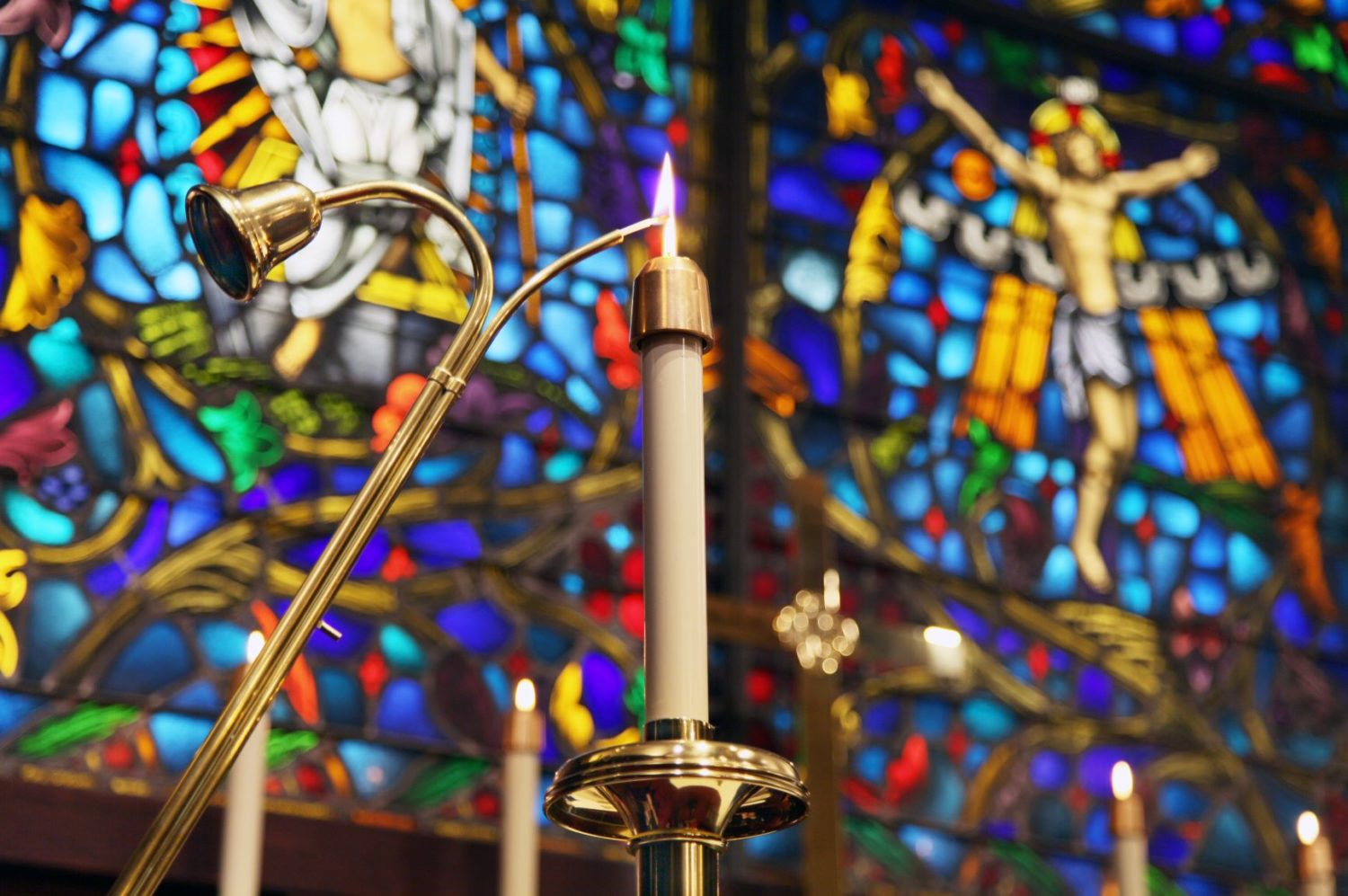St Mary’s Episcopal Church is fortunate to have a wonderful collection of more than thirty stained glass windows. Not only do they add beauty to St Mary’s but they add depth and dimension to our worship. They are a source from which we can learn much. In the time when the vast majority of people were illiterate, stained glass windows with their symbols and colors were one of the great sources of learning about God and His church. They can still serve as an inspiration to all who believe, particularly so if we have some understanding of the meaning of the symbols and colors used.
Throughout the ages certain standard symbols have become associated with various saints, but the colors in the windows also have significance. Red is the sign of danger and martyrdom, the warmth or orange signifies harvest-time and reflection. Green is the color of atmosphere, of fidelity and of life. Blue symbolizes coldness, distance, mystery as well as constancy, wisdom and charity and is the color of St Mary. Violet is the color of mourning, penitence, piety, humility and sadness. Purple is for richness regalness and royalty. White indicates purity, light and joy; black stands for evil, sin and despair.
Some of St Mary’s Windows are:
St Andrew
Andrew’s death tied to an X-shaped cross is depicted by the major symbol of this window. The crossed fish represent his early life as a fisherman before answering Jesus’ call. The V-shaped frame and spear are also shown.
St Mary
Although not scriptually based, the tradition of the Church describes Anne as wife of Joachim and mother of St Mary, the mother of Jesus. She holds a scroll and above her head is a lamp, both symbols of knowledge and enlightenment. The young birds in the nest are symbols of human souls.
St Barnabas
Shown with the Gospel and the pilgrim staff and wallet symbolic of his travels with St. Paul on the missionary journey, St. Barnabas is called the “Son of Encouragement.” Stones and hatchet were the instruments of his martyrdom.
St James
Located in St Mary’s narthex, this window represents the apostle James, one of the three closest to Jesus, who lived for about fourteen years after Christ’s death. The pilgrim’s staff and wallet refer to his tireless missionary zeal. The three scallop shells at the bottom symbolize Baptism and consequently conversion. The shell is combined with a sword represents beheading at the order of Herod Agrippa.
St John
The pen and book which St John holds are another of the symbols for the Evangelists. At the bottom is depicted a chalice from which a serpent emerges which is based upon a story of his enemies attempting to kill him by poisoning the Communion wine and his miraculous escape. The serpent coiled round a sword recalls man’s sin and the power of the Holy Spirit to overcome it.
St Joseph
Symbolic of his role as the protector of the Christ Child, Joseph carries a staff. The fleur-de-lis above is a stylization of the lily, symbolic of purity, in the Mary window. Below are found the carpenter’s axe and square.
St Luke
St Luke, a learned man, was a physician and artist as well as the author of one of the Gospels, thus the symbol of mortar and pestle, palette and brushes and pen and book.
St Mark
The symbol of the four Evangelists are derived from the Book of Revelation. Of the four beasts, Mark’s is the winged lion, beast of the wilderness, for his Gospel begins with “the voice of one crying in the wilderness.”
St Mary
The Virgin Mother is depicted as young but sorrowful. Above her head are seven swords representative of her sorrows derived from the prophecy of Simon “Yea, a sword shall pierce thine own soul also”. (Luke 2:35) The lily symbolizes purity.
St Mary Magdalene
Traditionally she is shown with flowing hair and a jar of ointment, although in centuries past only loose women wore their hair unbound. Although a sinner she was forgiven and it was to her that the Risen Lord first appeared after his resurrection. Her faithfulness to end and her presence at the crucifixion is sybolized by the crosses above her head and the skull at the bottom referring to Golgotha, the place of the skull. This symbol may also refer to the legend that after Pentecost she retired to the desert and lived as a hermit, bewailling her former sins.
St Matthew
Matthew is shown holding his Gospel and a bag of money, a symbol of his original calling as a tax collector. Above his head is a halberd and below a T-shaped cross, representative of his reported crucifixtion in Ethiopia on a Tau cross and the severing of his head from his body..
St Philip
Tau cross and the basket recall Philip’s presence when Jesus fed the multitude, and the loaves of bread and cross below are a variation on this. The dragon refers to a curious legend. After the Ascension he preached in Phrygia where he found the people addicted to the worship of a monstrous serpent or dragon, a form of the god Mars. At Philip’s command that the serpent disappear, the statue came to life and glided away from the altar, emitting such a hideous stench that many people sickened and died. One of these was the king’s son whom Philip restored to life, so incensing the priets of Mars that they stoned and crucified him.
St Thomas
As the patront saint of builders, because he is said to have gone to India to preach the Gospel and built there a church with his own hands, he holds a carpenter’s square. His martyrdom (which included being stoned, shot with an arrow and run through with a spear by a pagan priest) is symbolized by the stones below and spear above.
Most of the stained glass windows at St Mary’s were designed and crafted by the Willet Stained Glass Studio of Philadelphia.














